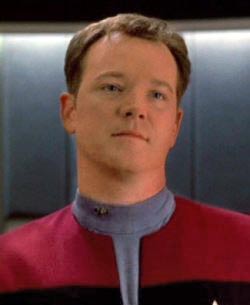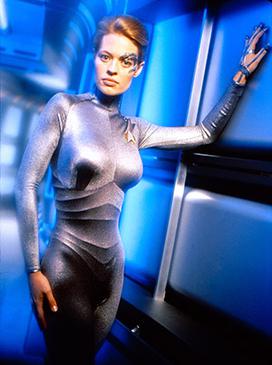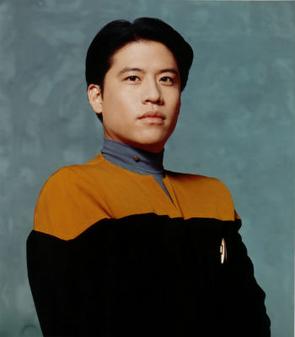Production
Writing and background
The producers had wanted to bring the Borg into Voyager, which resulted in numerous pitches from a variety of writers. There were concerns from some of the crew that the events of the film Star Trek: First Contact effectively destroyed the Borg, but executive producer Rick Berman clarified both that the death of the Borg Queen in the film did not mean the destruction of the entire collective and that there were other Borg remaining in the Delta Quadrant. [1] The alien race had made their first appearance in the Star Trek: The Next Generation episode "Q Who" and, at the time of the original broadcast of "Unity", had recently appeared in First Contact. [2] [3] The idea of Borg being separated from the collective had previously been seen in the episode of The Next Generation entitled "I, Borg" with the resultant effect seen in the two-part "Descent". [4] "Unity" was written by producer Kenneth Biller, [5] [6] with the final version of the script being submitted on November 7, 1996. [7] Though the film had not been released at the time he drafted the episode, Biller had read the First Contact script before writing the "Unity" script. [8]
Biller sought to give a more interesting look at the Borg, rather than simply focusing on their pursuit of assimilation. With this in mind, he thought of an idea based upon the Tower of Babel. [8] He said that the Borg was a "incredibly interwoven, complex community" and "once you knocked it all down you would have all these people who spoke different languages, and couldn't communicate with each other. It occurred to me that a group of ex-Borg would be a very interesting community to explore." [8] He wanted the potential reunification of the ex-Borg to be a moral dilemma. This was based on the growing favorable views of Communism in the Eastern bloc during the mid-1990s after the dissolution of the Soviet Union. [8]
Direction and editing

"Unity" was the second episode of Voyager to be directed by Robert Duncan McNeill following "Sacred Ground" from earlier in the season. He felt a great deal of pressure working on the episode which introduced the Borg to Voyager, and complained to the producers that the aliens only appear on two and a half pages of the script. He felt pressure in trying to produce something significant regarding the Borg because of the release of First Contact a few months earlier, and wanted to do something equally as exciting but without being repetitive. Instead, he wanted to give the viewer a sense of suspense and mystery regarding the people that Chakotay meets even if they do not appear to be Borg. McNeill saw "Unity" as being a type of film noir, with Chakotay being seduced by the Devil during the course of the story, and wanted to have a strong focus on this direction throughout the episode. [9]
This vision was included in the cinematography for the episode, with one scene having Captain Janeway stand over Chakotay's shoulder much in the same way that a guardian angel would. The set-up for that particular scene came from a collaboration between McNeill and actress Kate Mulgrew. From that, he developed a series of close-up shots to bring some intimacy to the scene. [9] The montage scene in the episode was created by McNeill, Biller, Jeri Taylor, Bob Ledermen and Wendy Neuss using footage from the episodes "Q Who" in The Next Generation, "Caretaker" from Voyager, as well as both "Emissary" and "The Way of the Warrior" from Deep Space Nine . [8]
McNeill also agreed with Biller's view that "Unity" was a metaphor for the break-up of the USSR, and McNeill read up on the subject before directing the episode, saying that "I think some of those ideas did come out in the story, even though it wasn't a really heavy, political episode. Yet there were some references and you could connect that to contemporary issues, individuality as opposed to group needs or desires." [10] McNeill was very happy with the resulting episode, saying that the Borg "were not as one-dimensional as previously depicted, but still as evil as ever", [11] and hoped to direct two or three more episodes in the following season. [9] By the end of Voyager, he had directed four episodes overall; this signalled a change in direction for his career into directing full-time. [12]
Design and special effects
To represent the ex-Borg colony on the planet, sets previously used for the episodes "The Chute" and "Fair Trade" from earlier in the season were used. [13] [14] This was further extended by the use of a computer generated matte painting created by freelancer Eric Chauvin. [15] Borg sets from First Contact were not re-used, but instead a new set was built. This new set measured 40 feet (12 m) in length curved around in a semi-circle, and McNeill was unsatisfied with this size. He said "It was the smallest set that I've ever seen in my life. We had no room on the stage to build a big Borg ship, because the other sets took up so much room." [8] He hoped that they had hidden this on camera, with it instead appearing as a series of separate corridors within the Borg vessel. McNeill explained that he had the actors walk the length of the set past the camera at the end, at which point a cut was made and they would go back to the start of the corridor to start filming again. [8]
Despite not using the sets, the episode did re-use the Borg costumes from First Contact, which McNeill described as "the scarier Borg" compared to those seen previously in The Next Generation. [8] This caused some problems with filming as an animatronic Borg arm used for the film was malfunctioning, leading to the production being stalled for several hours. [8] For First Contact, the Borg had been re-designed by Michael Westmore and Deborah Everton. The former and his makeup team had worked on the look of the heads, which included a variety of different Borg appliances which could be mixed and matched to create an ongoing variety of looks. For example, Westmore's colleague Jake Garber had created ten different eye pieces. [16] Everton, meanwhile, created the costumes for the Borg, and wanted them to be more elaborate than in previous appearances. This has been done with a view that individuals should look as if they had been transformed from the inside out, rather than the other way around. [17]
"Unity" also saw the first use of a fully computer generated Borg cube on screen. Those previously seen in the Star Trek franchise had been physical models, including the version seen in First Contact. [15] It was constructed by Emile Edwin Smith at Foundation Imaging, who mapped a cube with an image before creating raised areas with further detail. In order to make it look more three dimensional, he added interconnecting tubes and edge pieces to the model. [18] He explained on the Usenet newsgroup rec.arts.startrek.current that the episode used around 90 percent of shots featuring the new cube, while the remainder were stock footage created for earlier episodes. [19] Visual effects supervisor Mitch Suskin was pleased with the explosion of the Borg cube at the end of the episode, saying that "the only element was the explosion, the rest was accomplished in the CG domain. It was a real breakthrough. That was the first show that I really had no reservations about." [15]
Later influence

When later discussing the end of season episode "Scorpion" (part one), Brannon Braga said that the destroyed cube which appeared in "Unity" had a direct link to the action in that episode, as they wanted to hint at an alien species who could successfully fight the Borg. However, he also explained that there was no plans to bring back the "Co-operative" as seen in "Unity", saying that "The Co-operative is long gone, man. It's been months since we've seen the Co-operative. That's not to say we won't learn someday what happened to them. That's kind of an interesting question." [20] They returned in "Delta Rising", an expansion for Star Trek Online , where they had grown to encompass a large number of liberated Borg, including their vessels. [21]
It was originally intended to include a "Borg graveyard" in space in "Unity", [20] similar to the vision of the destroyed Federation ships seen after the Battle of Wolf 359 in The Next Generation episode "The Best of Both Worlds". The scene was instead shown in the first part of "Scorpion". [20] One link remained in the "Unity" script: Riley Frazier was stated to have been abducted by the Borg while she was on the USS Roosevelt during the battle. [22]





